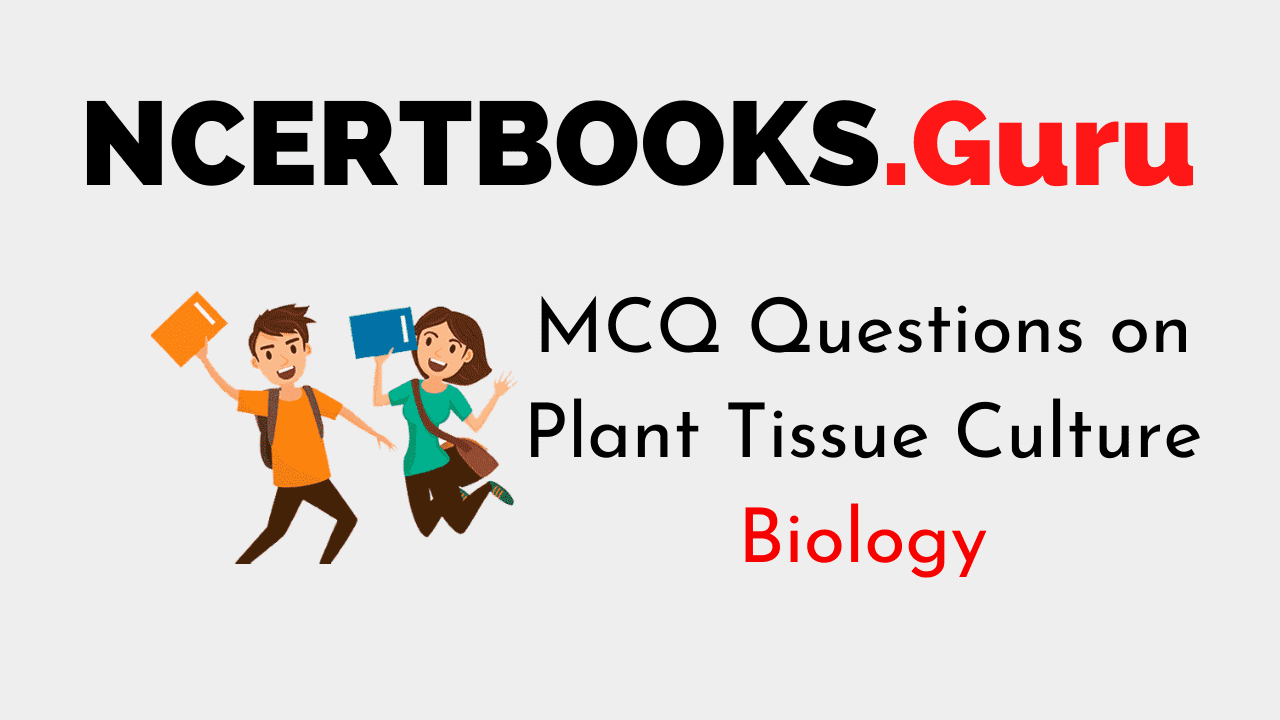Biology is the study of life. Below, You will find a list of Biology MCQ Questions as per the latest prescribed syllabus. Ace up your preparation with the Objective Questions available on Plant Tissue Culture and enhance your subject knowledge. Understand the concept clearly by consistently practicing the Multiple Choice Questions and score well in your exams.
MCQ Questions on Plant Tissue Culture
1. Who is known as the father of tissue culture?
(a) Bonner
(b) Laibach
(c) Haberlandt
(d) Gautheret
Answer
Answer: (c) Haberlandt.
2. The production of secondary metabolites requires the use of ________.
(a) Meristem
(b) Protoplast
(c) Axillary buds
(d) Cell suspension
Answer
Answer: (d) Cell suspension.
3. The pair of hormones required for a callus to differentiate are________.
(a) Ethylene and Auxin
(b) Auxin and cytokinin
(c) Auxin and Abscisic acid
(d) Cytokinin and gibberellin
Answer
Answer: (b) Auxin and cytokinin.
4. What is Dimethyl sulfoxide used for?
(a) A gelling agent
(b) Cryoprotectant
(c) Chelating agent
(d) An Alkylating agent
Answer
Answer: (b) Cryoprotectant.
5. The formation of embryoids from the pollen grains in the tissue culture medium is due to ________.
(a) Organogenesis
(b) Test tube culture
(c) Double fertilization
(d) Cellular totipotency
Answer
Answer: (d) Cellular totipotency.
6. Synthetic seeds are produced by the encapsulation of somatic embryos with___________.
(a) Sodium acetate
(b) Sodium nitrate
(c) Sodium chloride
(d) Sodium alginate
Answer
Answer: (d) Sodium alginate.
7. Totipotency refers to ___________.
(a) Development of fruits from flowers in a culture
(b) Development of an organ from a cell in a culture medium
(c) Flowering in a culture medium
(d) All of the above
Answer
Answer: (b) Development of an organ from a cell in a culture medium.
8. Which of the following is the main application of embryo culture?
(a) Clonal propagation
(b) Production of embryoids
(c) Induction of somaclonal variations
(d) Overcoming hybridisation barriers
Answer
Answer: (d) Overcoming hybridisation barriers.
9. In tissue culture of parenchyma, mitosis is accelerated in the presence of ________.
(a) Auxin
(b) Cytokinin
(c) Gibberellin
(d) Both auxin and cytokinin
Answer
Answer: (d) Both auxin and cytokinin.
10. In which of the following conditions do the somaclonal variations appear?
(a) Plants raised in tissue culture
(b) Plants exposed to gamma rays
(c) Plants growing in polluted soil or water
(d) Plants transferred by a recombinant DNA technology.
Answer
Answer: (a) Plants raised in tissue culture.
11. Haploid plants can be obtained from________.
(a) Anther culture
(b) Bud culture
(c) Leaf culture
(d) Root culture
Answer
Answer: (a) Anther culture.
12. In-plant tissue culture, the callus tissues are generated into a complete plantlet by altering the concentration________.
(a) Sugars
(b) Hormones
(c) Amino Acids
(d) Vitamins and minerals
Answer
Answer: (b) Hormones.
13. Which of the following is cultured to obtain haploid plants?
(a) Embryo
(b) Nucleus
(c) Apical bud
(d) Entire anther
Answer
Answer: (d) Entire anther.
14. Which of the following vectors is used in crop improvement and crop management?
(a) Agrobacterium
(b) Plasmid
(c) Cosmid
(d) Phasmid
Answer
Answer: (a) Agrobacterium.
15. Which of the following growth hormones produces apical dominance?
(a) Ethylene
(b) Cytokinin
(c) Auxin
(d) Gibberellin
Answer
Answer: (c) Auxin.
16. Cybrids are produced by
(a) The nucleus of one species but cytoplasm from both the parent species
(b) The fusion of two same nuclei from the same species
(c) The fusion of two different nuclei from different species
(d) None of the above
Answer
Answer: (a) Nucleus of one species but cytoplasm from both the parent species.
17. Which of the following mediums is composed of chemically defined compounds?
(a) Natural media
(b) Artificial media
(c) Synthetic media
(d) None of the above
Answer
Answer: (c) Synthetic media.
18. Which of the following chemicals are most widely used for protoplast fusion?
(a) Mannitol
(b) Polyethylene glycol
(c) Sorbitol
(d) Mannol
Answer
Answer: (b) Polyethylene glycol.
19. Which of the following plant cells shows totipotency?
(a) Cork cells
(b) Meristem
(c) Sieve tube
(d) Xylem vessels
Answer
Answer: (b) Meristem.
20. What is Callus?
(a) Tissues that grow to form an embryoid
(b) An unorganised actively dividing the mass of cells maintained in a culture
(c) An insoluble carbohydrate
(d) A tissue that grows from an embryo
Answer
Answer: (b) An unorganised actively dividing mass of cells maintained in culture.
